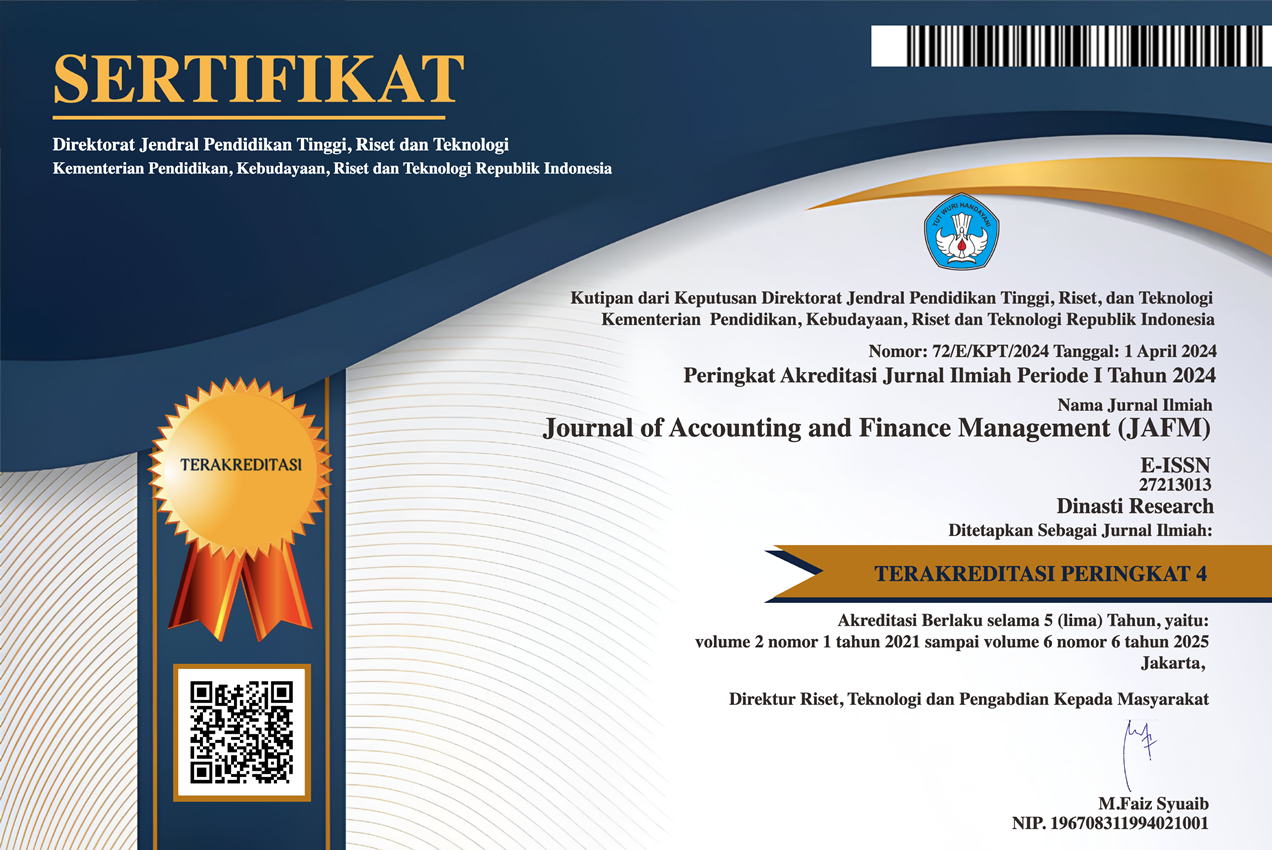Analysis of Mobile Banking Usage and Other Factors on Banking Productivity in Indonesia Using the Malmquist Productivity Index (MPI) Approach
DOI:
https://doi.org/10.38035/jafm.v5i4.804Keywords:
Banking Efficiency, Fintech, Malmquist Productivity Index, Mobile Banking, Technological InnovationAbstract
This study analyzes the impact of fintech technology on the productivity and efficiency of traditional banks in Indonesia that provide mobile banking services. While fintech has improved financial transactions and operational efficiency, previous research shows mixed results regarding the effect of fintech on bank productivity. This study fills the research gap by analyzing how fintech integration affects the efficiency of traditional banks using recent data. Using the Malmquist Productivity Index (MPI), this study evaluates the efficiency of nine traditional banks in Indonesia based on annual report data. The variables analyzed include Mobile Transaction Market Share (PH), Gross Domestic Product (GDP), Non-Performing Loan Ratio (NPL), Capital Ratio (CAP), Total Assets (A), and M2 Exchange Rate (MS). The descriptive analysis results show that the variables of NPL, CAP, and total assets have no significant impact on productivity. However, GDP and M2 have a strong influence on improving bank efficiency through fintech technology. This study concludes that fintech is important to improve banking efficiency in Indonesia and banks should prioritize technological innovation to boost productivity. Further research is needed to explore additional variables in this relationship.
References
AlHarbi, A., Sbeiti, W., & Ahmad, M. (2024). Money Supply, Banking, and Economic Growth: A Cross Country Analysis. International Journal of Economics and Financial Issues, 14(2), 234–242. https://doi.org/10.32479/ijefi.15749
Amin, N. F., Garancang, S., & Abunawas, K. (2023). Konsep Umum Populasi Dan Sampel dalam Penelitian. Jurnal Pilar: Jurnal Kajian Islam Kontemporer, 14(1).
Ayuningtyas, M., & Sufina, L. (2023). Pengaruh Penggunaan Mobile Banking, Internet Banking, dan Atm terhadap Kinerja Keuangan Perbankan (Studi Kasus Sektor Bank Konvensional yang Terdaftar di Bursa Efek Indonesia) Tahun 2017- 2021. Jurnal Keuangan Dan Perbankan, 19(2). https://doi.org/10.35384/jkp.v19i2.394
Cho, T.-Y., & Chen, Y.-S. (2021). The impact of financial technology on China’s banking industry: An application of the metafrontier cost Malmquist productivity index. North American Journal of Economics and Finance, 57. https://doi.org/10.1016/j.najef.2021.101414
Çollaku, B., & Aliu, M. (2021). Impact of Non-Performing Loans on Bank’s Profitability: Empirical Evidence from Commercial Banks in Kosovo. Journal of Accounting Finance and Auditing Studies (JAFAS), 7(3), 226–242. https://doi.org/10.32602/jafas.2021.027
Dewi, D. D., & Octrina, F. (2022). Pengaruh Era Digital Terhadap Kinerja Keuangan Perbankan BUMN Periode 2013-2020. E-Proceeding of Management, 9(4). https://openlibrary.telkomuniversity.ac.id/pustaka/files/179993/jurnal_eproc/analisis-pengaruh-era-digital-terhadap-kinerja-keuangan-perbankan-bumn-periode-2013-2020.pdf
Efendi, N. A. (2024). Analisis Pengaruh Mobile Banking Terhadap Kinerja Teller Melayani Transaksi Studi Kasus (BSI KCP Medan Kampung Baru). CEMERLANG?: Jurnal Manajemen Dan Ekonomi Bisnis, 4(1), 160–167. https://doi.org/10.55606/cemerlang.v4i1.2308
Fajari, S., & Sunarto, S. (2017). Pengaruh Car, Ldr, Npl, Bopo Terhadap Profitabilitas Bank ( Studi Kasus Perusahaan Perbankan Yang Tercatat Di Bursa Efek Indonesia Periode Tahun 2011 Sampai 2015 ). Prosiding Seminar Nasional Multi Disiplin Ilmu &Call For Papers Unisbank Ke-3 (SENDI_U 3).
Färe, R., & Grosskopf, S. (1994). Estimation of returns to scale using data envelopment anab, sis: A comment. European Journal of Operational Research, 79(2), 379–382. https://doi.org/10.1016/0377-2217%2894%2990366-2
Fitriyani, E., Kamal, H., & Mukhtasar. (2023). Influence Of Mobile Banking Service The Number Of Customers Bank Aceh Islamic Kcp Batuphat, Lhokseumawe. AT-TIJARAH: Jurnal Penelitian Keuangan Dan Perbankan Syariah, 5(2), 68–80. https://doi.org/10.52490/attijarah.v5i2.1946
Fu, J., & Mishra, M. (2021). Fintech in the time of COVID-19: Technological adoption during crises. Swiss Finance Institute Research, 50, 20–38.
Ghosh, S. K., & Maji, S. G. (2019). Profitability of Banks in India: Impacts of Market Structure and Risk. Journal of Applied Finance & Banking, 9(6). https://www.researchgate.net/publication/339069516
Jahan, N. (2019). Productivity Analysis of Commercial Banks of Bangladesh: A Malmquist Productivity Index Approach. International Journal of Economics and Financial Issues, 9(1), 108–115. https://doi.org/10.32479/ijefi.7302
Kamboj, S., Sharma, M., & Sarmah, B. (2022). Impact of mobile banking failure on bank customers’ usage behaviour: the mediating role of user satisfaction. International Journal of Bank Marketing, 40(1), 128–153. https://doi.org/10.1108/IJBM-10-2020-0534
Kasmir. (2022). Pengantar Metodologi Penelitian untuk Ilmu Manajemen Akuntansi dan Bisnis (1st ed.). PT. RajaGrafindo Persada.
Khaksar, M., & Malakoutian, M. M. A. (2020). Productivity Evaluation for Banking System in Developing Countries: DEA Malmquist Productivity Index Based on CCR, BCC, CCR-BCC (A Case Study). ENG Transactions, 1, 186. http://www.engtransactions.com
Miah, M. D., & Uddin, H. (2017). Efficiency and stability: A comparative study between islamic and conventional banks in GCC countries. Future Business Journal, 3(2), 172–185. https://doi.org/10.1016/j.fbj.2017.11.001
Novitasari, C. A., Manggabarani, A. S., & Astuti, M. (2021). Analisis Kepuasan Nasabah Mobile Banking Pada Bank BCA. Jurnal Teknologi Dan Manajemen, 19(2), 1–12. https://doi.org/10.52330/jtm.v19i2.26
Octrina, F., & Pratidina, R. (2021). Produktivitas Bank Umum Konvensional Di Indonesia Menggunakan Malmquist Productivity Index (Studi Kasus Pada Buku I Dan Buku II Tahun 2016-2019). EProceedings of Management, 8(5).
Octrina, F., Setiawati, R., Asnawi, A., & Putri, R. K. (2020). Produktivitas Perbankan Indonesia Dengan Pendekatan Malmquist Index Productivity. Jurnal Sain Manajemen, 2(1). https://doi.org/10.51977/jsm.v2i1.186
OJK. (2023). Statistik Perbankan Indonesia. Otoritas Jasa Keuangan. https://ojk.go.id/id/kanal/perbankan/data-dan-statistik/statistik-perbankan-indonesia/default.aspx
Ralevi?, P., Dobrodolac, M., Švadlenka, L., Šarac, D., & ?uri?, D. (2020). Efficiency and productivity analysis of universal service obligation: A case of 29 designated operators in the european countries. Technological and Economic Development of Economy, 26(4), 785–807. https://doi.org/10.3846/tede.2020.12062
Rashid, M. H. U., Zobair, S. A. M., Chowdhury, M. A. I., & Islam, A. (2020). Corporate governance and banks’ productivity: evidence from the banking industry in Bangladesh. Business Research, 13(2), 615–637. https://doi.org/10.1007/s40685-020-00109-x
Riady, D. K., Soemitra, A., & Nawawi, Z. M. (2022). Growth in Financial Technology (Fintech) Transactions in Banking During the Covid- 19 Pandemic. Management Studies and Entrepreneurship Journal, 3(2). http://journal.yrpipku.com/index.php/msej
Safari, A., & Riyanti, A. (2024). Analisis Technology Acceptance Model (Tam) Terhadap Minat Penggunaan Mobile Banking. Jurnal Ilmiah Edunomika, 8(1). https://jurnal.stie-aas.ac.id/index.php/jie/article/view/10490
Sugiyono. (2020). Metode Penelitian Kuantitatif, Kualitatif dan R&D (2nd ed.). Alfabeta.
Susanto, P. C., Arini, D. U., Yuntina, L., Soehaditama, J. P., & Nuraeni. (2024). Konsep Penelitian Kuantitatif: Populasi, Sampel, dan Analisis Data (Sebuah Tinjauan Pustaka). Jurnal Ilmu Multidisiplin, 3(1). https://doi.org/10.38035/jim.v3i1.504
Ulfa, R. (2020). Variabel Penelitian Dalam Penelitian Pendidikan. Jurnal Pendidikan Dan Keislaman, 10(1), 342–351. https://jurnal.stitbb.ac.id/index.php/al-fathonah/article/download/44/29
Wooldridge, J. M. (2019). Correlated random effects models with unbalanced panels. Journal of Econometrics, 211(1), 137–150. https://doi.org/10.1016/j.jeconom.2018.12.010
Zavolokina, L., Dolata, M., & Schwabe, G. (2016). The FinTech phenomenon: antecedents of financial innovation perceived by the popular press. Financial Innovation, 2(1). https://doi.org/10.1186/s40854-016-0036-7
Downloads
Published
How to Cite
Issue
Section
License
Copyright (c) 2024 Yohana Marnala Marpaung, Fajra Octrina

This work is licensed under a Creative Commons Attribution 4.0 International License.
Authors who publish their manuscripts in this journal agree to the following conditions:
- The copyright on each article belongs to the author(s).
- The author acknowledges that the Journal of Accounting and Finance Management (JAFM) has the right to be the first to publish with a Creative Commons Attribution 4.0 International license (Attribution 4.0 International (CC BY 4.0).
- Authors can submit articles separately, arrange for the non-exclusive distribution of manuscripts that have been published in this journal into other versions (e.g., sent to the author's institutional repository, publication into books, etc.), by acknowledging that the manuscript has been published for the first time in the Journal of Accounting and Finance Management (JAFM).



























